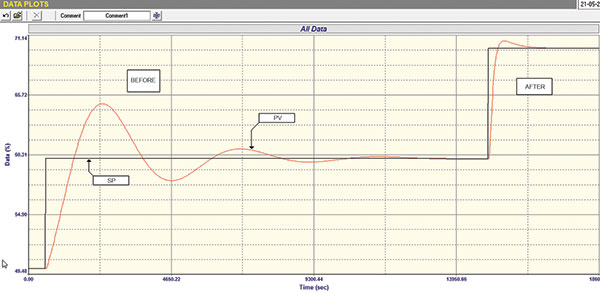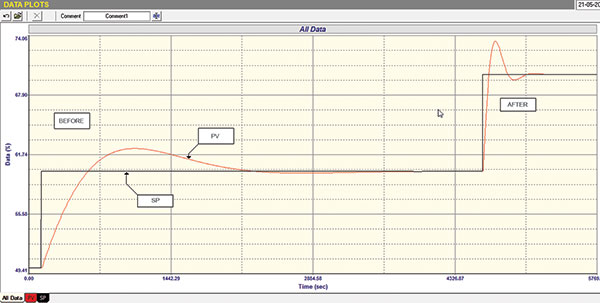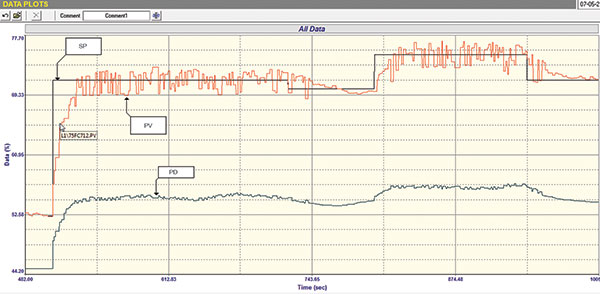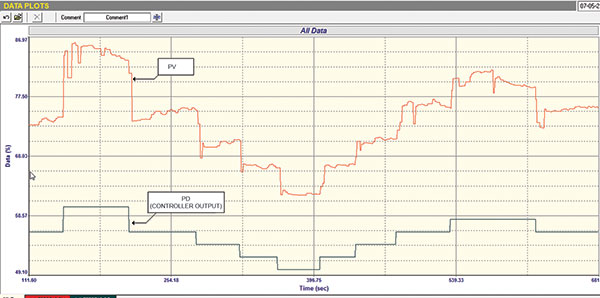
Following from the last Case History article, number 132, about interesting loops in a chemical plant where I do a lot of optimisation, here are a few more examples of interesting loops.
The basics of level control
The first two examples are of tuning of level control. Level processes fall under the category of integrating, or ramping processes and there are numerous articles in the Loop Signature series where the subject of optimising integrating processes is covered. As mentioned there, this class of process is not at all well understood by the vast majority of people who perform optimisation. Integrating processes, for many reasons, tend to be cyclic if problems like valve hysteresis exist and bad tuning can exacerbate this. When it comes to tuning, integrating processes are invariably tuned far worse than the other class of processes, known as self-regulating systems.
There are mainly two types of level controls:
1. Tight level control: this is where the control requirement is to hold the level as constant as possible and keep it at set-point under all conditions of load disturbances. The tuning for this must be as fast as possible. Therefore one needs to use high controller gains to allow the valve to respond quickly to changes. (Remember that in general there is a relatively high volume of liquid in the vessel in comparison with the volume of liquid passing through the valve. Therefore if one wants a response to be as fast as possible, you must get the valve to move quickly.)
2. Surge level control: this is used where the vessel is designed to store or hold enough liquid so that a constant flow can be passed to downstream processes, irrespective of changes in the flow entering the vessel. Therefore if we have a valve to control the level on the output side of the vessel, then one must try to minimise movements of this valve. This requires slow tuning or even better to use techniques without an actual controller as described in the first Loop Signature series in Article LS29-1.
The examples covered in this article are where the control requirement is for the first case of tight level control.
Tuning considerations
Many C&I practitioners have a general fear of using high proportional gains in controllers, obviously due to a fear of causing instability. Most self-regulating processes need relatively low gain in the controllers, however, for the majority of integrating processes, particularly for level controls with relatively long tank retention times, much higher gains can be used. As a general rule, one would probably not need gains higher than 15, most tight levels have gains varying between 3 and 15.
The problem with level controls comes with the integral term in the controller that can cause various problems which result in cyclic behaviour of the loop when the controller is in automatic. Typically, any valve hysteresis on integrating processes tuned with both proportional and integral terms will result in continuous cycling of the loop. Integrating processes generally also need much longer integral times than self-regulating processes. But, if the integral is too fast, then the loop will become cyclic which causes continuous oscillation.
Most people who do tuning have a good understanding of self-regulating processes and can usually achieve a set-up which is stable – although the vast majority of loops are tuned far too slowly. When it comes to integrating processes, a completely different mindset is needed for tuning, and as few people have been taught this, the tuning is usually very poor being extremely slow and cyclic.
Practical examples
The first example is of a level control which was incredibly badly tuned. The process had a retention time of approximately 16 minutes, which is not very large and the original tuning was set with a proportional gain of 0,8 and an integral of 7 minutes per repeat.

A set-point step change of 10% was made and a very slow cyclic response resulted. In Figure 1 it can be seen that with this tuning the process had not settled completely at set-point, even after 4 hours!
Medium fast tuning of the Protuner loop analysis software gave a tune with a proportional gain of 9,0 and an integral of 9 minutes per repeat. The response to the same set-point change gave a reasonable response with only one overshoot and the process settled completely within 30 minutes. This is a wonderful example of a badly tuned level loop.

Figure 2 shows the before and after tuning of another level loop. This one was very difficult to tune because the process is subject to frequent and large load disturbances, and it was very hard to get quiescent periods during which open loop tests could be performed to obtain a good and representative process dynamic signature to allow tuning to be calculated. It took over an hour to run these tests, which could have been completed within a few minutes if conditions had been stable. This is where experience comes in. One has to perform numerous tests and compare them to find repeatable responses from which the process dynamics will allow good tuning.
It can be seen that the closed loop response to a step change in set-point was again dramatically improved with the new tuning. The original tuning was set with a proportional gain of 0,5 and an integral of 9,1 minutes per repeat. The new tune gave a proportional gain of 4 and an integral of 5 minutes per repeat.
The third example is of a flow loop that was always cycling. As usual, nearly everyone in a plant immediately assumes that if a loop is cycling then the tuning is wrong, and in this case, many attempts had been made to try and tune out the cycling.

Figure 3 shows a closed loop response to step changes in set-point after a Protuner tuning. As far as the response is concerned the tuning is pretty good for a flow loop. The proportional gain was 0,1 and the integral 0,04 minutes per repeat. (The original tuning was useless with a gain of 0,8 and an integral of 0,5 minutes per repeat.)
It can be seen in the test that the process was in an almost continuous cycle. This was not due to the tuning. The reason for the cycling can be clearly seen in the open loop test shown in Figure 4, which shows that on virtually every step change the valve over and undershot, sometime several times. This is because the positioner is almost completely unstable.

Conclusion
Unfortunately in these modern days of ‘smart’ measuring and control equipment, many people assume that the computerisation automatically takes care of everything. However, one often has to set up the computer in the equipment to do this. In the case of smart positioners, particularly the more sophisticated ones, there is a PI controller in the positioner which also has to be tuned. Positioners, for many reasons outside the scope of this article, are a potential source of instability on fast processes like flow and need careful tuning.
I always enjoy finding and solving loop problems like these. Approximately 50% of control loops have similar problems and plant personnel often do not even know that they exist.

Michael Brown is a specialist in control loop optimisation with many years of experience in process control instrumentation. His main activities are consulting, and teaching practical control loop analysis and optimisation. He gives training courses which can be held in clients’ plants, where students can have the added benefit of practising on live loops. His work takes him to plants all over South Africa and also to other countries. He can be contacted at Michael Brown Control Engineering cc, +27 (0)82 440 7790, [email protected], www.controlloop.co.za
| Email: | [email protected] |
| www: | www.controlloop.co.za |
| Articles: | More information and articles about Michael Brown Control Engineering |

© Technews Publishing (Pty) Ltd | All Rights Reserved